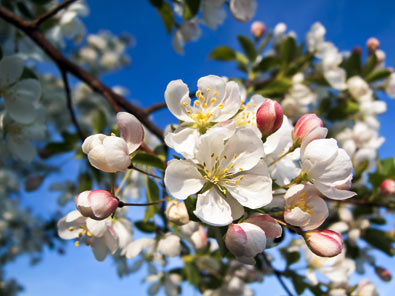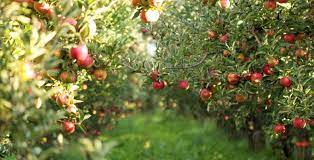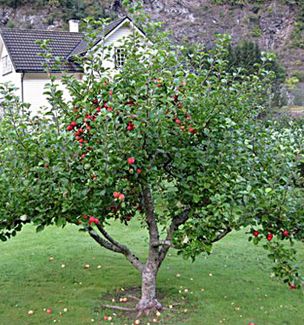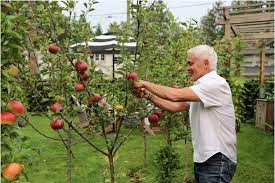Plant an apple tree in your garden

One of the joys of having a garden is the opportunity not only to enjoy the beauty of flowering plants, but of growing your own fruits and vegetables. Fruit trees are especially rewarding since they produce beautiful blossoms in the spring and summer as well as delicious things to eat.

When deciding which fruit trees to plant, make sure to choose trees that not only produce your favorite fruits but that can survive and thrive in the sometimes challenging weather of northern Illinois.
The fruit trees that are most successful in this part of the state are apple, pear, plum and sour cherry. Others such as peaches and apricots, can also be cultivated but fare better in more southern regions. Just remember that fruit trees are a long-term commitment since they can take years to fully mature. Apple trees, for example, can take five to ten years to blossom and produce fruit.
You could start by planting seeds but planting a young fruit tree that’s already three or four years old will speed up the process. Make sure you consider the space, sunlight,\ and type of soil your tree needs when choosing exactly where to plant it.
Here are some other things to consider:
Apple trees can produce a lot of fruit!
Every variety of apple has a different flavor, texture, smell and color. Since an average apple tree produces 1,500 apples a year, make sure you’ll enjoy them and want to share them with your friends! Try different varieties and decide which ones you like best.

Some trees are self-pollinating, but others need to be planted with another tree.
Before trees can grow fruit, they have to produce blossoms. These blossoms produce pollen that must be carried from the male part of the flower to the female part. Some types of fruit trees may be pollinated by their own pollen such as Golden Delicious, Braeburn, Granny Smith and Scrumptious. These trees are said to be self-fruitful. Others need to get pollen from a different tree of the same species. Still others may receive pollen from a different variety of tree.

If you need more than one tree for the pollination process, consider how much ground you’ll need to accommodate them. Keep in mind that trees grow underground as well as above. As they grow, tree roots can cause problems with driveways, sidewalks, patios and underground pipes. Make sure you allow enough space for the tree to grow out as well as up.

Dwarf fruit trees take less space to grow than full-size trees.
Apple trees may be dwarfed naturally or because fruit tree growers graft or bud them to a dwarfing rootstock, limiting the overall size. If they are naturally dwarfed, then the apples listed will be a “spur-type” tree. They come in a number of popular varieties including Empire, Red and Yellow Delicious, McIntosh, Rome, Winesap and Early Blaze, to name just a few. One disadvantage is that their fruit is smaller than that of full-sized trees. The plus side is that they are easier to train, prune and maintain and produce fruit sooner than full size trees. They may also be more suitable if you have a smaller yard in which to plant them.

Different varieties of the same fruit bloom at different times.
Apple trees can produce fruit that ripens in the summer, in the early or late fall and even in the winter. This should be taken in to consideration, too, when planning what you’ll plant and when.
Ripening Schedule for Apples
Summer: Stark Earliest, Viking Transparent, Pristine
Early Fall: Gala
Fall: McIntosh, Golden Delicious, Red Delicious
Winter: Fuji

Final Tip: To get the most out of your garden, consult an expert.
Once you decide to invest in fruit trees for your garden, try to read everything you can about planting, cultivating and harvesting. In addition, consult an expert in what to plant, how to plant it and the issues your property may present that could hinder successful cultivation. An expert can help you buy the right plants at the best time and from the best supplier. They can also provide the tools and labor you need to transport and plant your trees.
Agriculture may be your hobby, but it takes years of experience to become as knowledgeable as a professional landscaper. Fruit trees need to be properly pruned and fertilized, and, by working with a landscaping partner, you can avoid costly mistakes. Together, you can develop a maintenance schedule that makes the most effective use of your time and budget to achieve the best results.

If you’d like to find out more about making fruit trees part of your landscaping, please call us at 847-912-6319. I’d love to help.
Thanks for reading,
Curt




